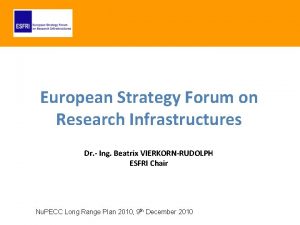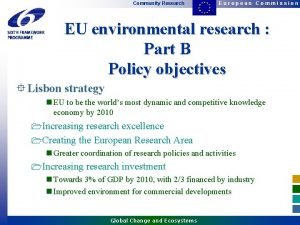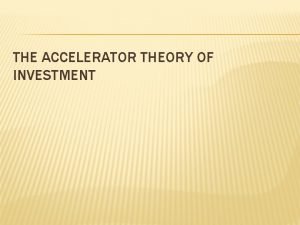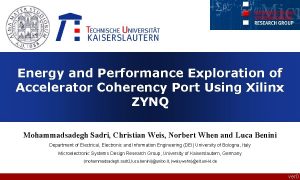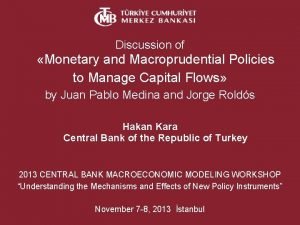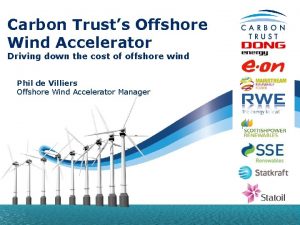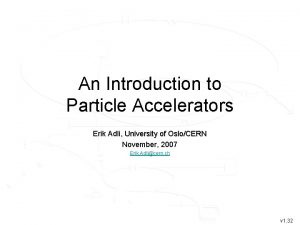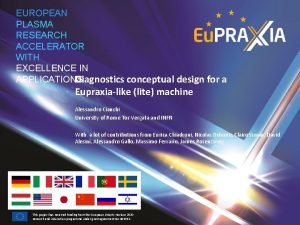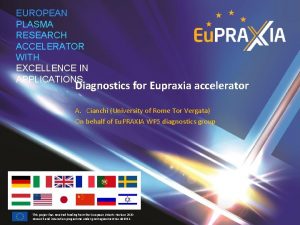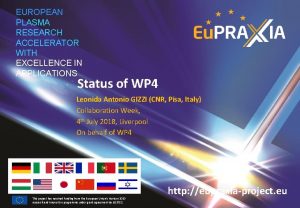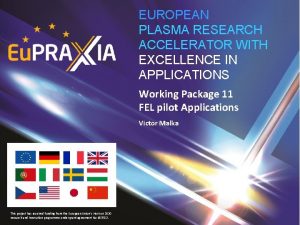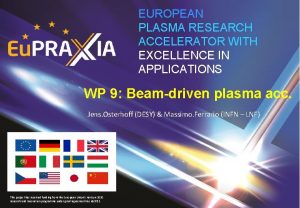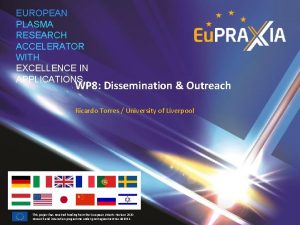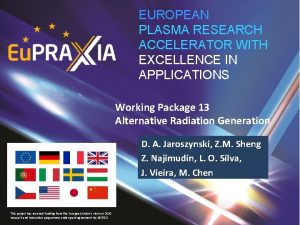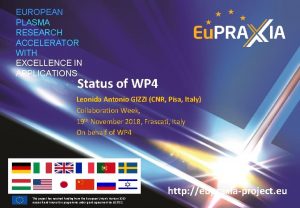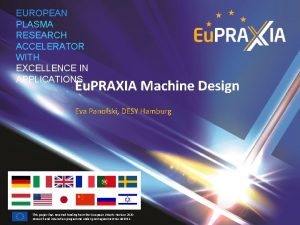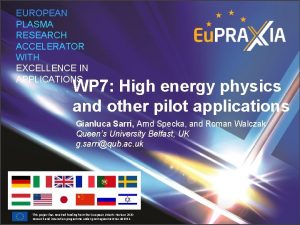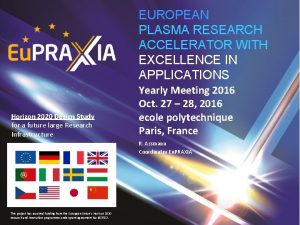EUROPEAN PLASMA RESEARCH ACCELERATOR WITH EXCELLENCE IN APPLICATIONS












- Slides: 12

EUROPEAN PLASMA RESEARCH ACCELERATOR WITH EXCELLENCE IN APPLICATIONS Electron Beam Design and Optimization (WP 5) Antoine Chance on behalf of WP 5 collaboration This project has received funding from the European Union’s Horizon 2020 research and innovation programme under grant agreement No 653782.

RF Injector Highlights Task WP 5. 1 Horizon 2020 • Start-to-End simulations from the cathode to the plasma module – Full RF compression for LWFA external injection (INFN) • 3 S-band TW sections and X-band booster – Full RF compression for PWFA (INFN) • 3 S-band TW sections and X-band booster Transverse phase space at the plasma entrance – Hybrid compression (DESY)

RF Injector Highlights Task WP 5. 1 Horizon 2020 • Creation of a new work package dedicated to diagnostics: WP 15. • Advances on this topic in the WP 15 presentation. Design report photo-injector A. Chance 3 rd Eupraxia Collaboration week – Liverpool 4 th – 5 th July 2018 3

Beam line Task WP 5. 2 Horizon 2020 • Close loop with WP 2 to get distributions and transport them in transfer lines. • Theoretical studies have given a recommended strategy for WP 2: Energy spread should be minimized jointly with the Twiss parameter �� 0 at the plasma exit. The total length and the integrated focusing strength in the transfer line should be minimized also. • Optimization of the transfer lines to keep the beam quality and to match to second plasma stage (conditions from WP 2) or to users (WP 6 and WP 7). • First discussions with WP 15 (diagnostics) to find the allocated place for diags. A. Chance 3 rd Eupraxia Collaboration week – Liverpool 4 th – 5 th July 2018 4

Beam lines Task WP 5. 2 Quadrupole Length • • • Max Gradient • Permanent 100 mm 660 T/m Electromagnets 400 mm 88 T/m Exit of the 5 Ge. V LPA Permanent quadrupoles Horizon 2020 Low energy spread: only 0. 2% Low emittance growth . 24 p. C Next steps: – Allocate some place for diags. – Laser removal. Distribution from – Optimize magnets. Undulator entrance A. Rossi Electromagnet quadrupoles A. Chance 3 rd Eupraxia Collaboration week – Liverpool 4 th – 5 th July 2018 5

Beam lines Task WP 5. 2 Quadrupole Length • • • Max Gradient • Permanent 120 mm 570 T/m Electromagnets 200 mm 23 T/m Exit of the 5 Ge. V LPA Horizon 2020 Low energy spread: only 0. 2% for slice Low emittance growth . 25 p. C Next steps: – Allocate some place for diags. – Laser removal. – Optimize magnets. Undulator entrance Distribution from X. Li Dipoles Permanent quadrupoles Electromagnet quadrupoles A. Chance 3 rd Eupraxia Collaboration week – Liverpool 4 th – 5 th July 2018 6

Chicane and dogleg Task WP 5. 2 • • 1 mm Horizon 2020 C-chicane: no bunch lengthening if deflection of a few mm . Scaling laws exist Small normalized dispersion: small collimation efficiency. Next step: Laser removal. 5 mm Distribution from X. Li Undulator entrance • • • Dogleg: needs for more place to have a deflection of 600 mm @ 5 Ge. V (needed to avoid the undulators). Large emittance growth: factor 2 -3 Next steps: – Scaling laws to optimize the line – To improve the beam line A. Chance 3 rd Eupraxia Collaboration week – Liverpool 4 th – 5 th July 2018 7

Beam lines Task WP 5. 2 Quadrupole Length • • • Max Gradient • Permanent 45 mm 211 T/m Exit of the LPI Horizon 2020 Space charge included Emittance growth within requirements . 30 p. C Next steps: – Allocate some place for diags. – Laser removal and injection. Distribution from P. – Optimize magnets. Entrance of the LPAS Tommassini Permanent quadrupoles A. Chance 3 rd Eupraxia Collaboration week – Liverpool 4 th – 5 th July 2018 8

Beam line between 2 stages Task WP 5. 2 Horizon 2020 • Plasma lenses are a promising alternative: – More compact. – Smaller emittance growth (focusing in both planes). • Next steps: – To check that wakefield generated from bunch is negligible – To optimize plasma len parameters. Initial A. Chance 3 rd Eupraxia Collaboration week – Liverpool 4 th – 5 th July 2018 Final 9

Beam lines Task WP 5. 2 • • • Quadrupole Length Max Gradient Permanent 100 mm 318 T/m Electromagnets 100 mm 21 T/m Exit of the 1 Ge. V LPA • Horizon 2020 Large emittance growth . 23 p. C With collimators in chicane (deflection of 2 mm), driver can be removed (>95% lost) Next steps: – Allocate some place for diags. – Laser removal. – Optimize magnets. Undulator entrance Distribution from Marocchino Dipoles Permanent quadrupoles Electromagnet quadrupoles A. Chance 3 rd Eupraxia Collaboration week – Liverpool 4 th – 5 th July 2018 10

Summary Horizon 2020 • Design of the photoinjector exists and in good shape. • Design of most transfer lines exists. • Next steps: – Design of the left transfer lines (dogleg for WP 7). – Tolerance studies. – Start-to-end simulations (from plasma injector to users). A. Chance 3 rd Eupraxia Collaboration week – Liverpool 4 th – 5 th July 2018 11

Response to last recommendations Horizon 2020 • Rec 19. SAC recommends including the diagnostics for the pre-acceleration injection of the beam in the overall analysis. These diagnostics could be the subject of experimental investigation at one of the two facilities proposed for external injection, at Flash Forward or at SPARC. – Dedicated work package WP 15. • Rec 20. SAC recommends analysing the expected effects of electron scattering in the gas, the effect on the emittance growth and the resulting dose irradiated. – Until now, effort was focused on transporting the beam in the transfer line (emittance growth was non negligible). – Several loops occurred between WP 5 and WP 2: beam distributions have evolved. – Not yet studied. Should be done. A. Chance 3 rd Eupraxia Collaboration week – Liverpool 4 th – 5 th July 2018 12
 Eden european destinations of excellence
Eden european destinations of excellence Abu dhabi award for research excellence (aare)
Abu dhabi award for research excellence (aare) European strategy forum on research infrastructures
European strategy forum on research infrastructures European commission community research
European commission community research Grasp model
Grasp model Criticism of accelerator theory of investment
Criticism of accelerator theory of investment Biztalk accelerator for swift
Biztalk accelerator for swift Accelerator forced rescan
Accelerator forced rescan Econ crowding out
Econ crowding out Accelerator coherency port
Accelerator coherency port Financial accelerator
Financial accelerator Offshore wind accelerator
Offshore wind accelerator Erik adli
Erik adli


